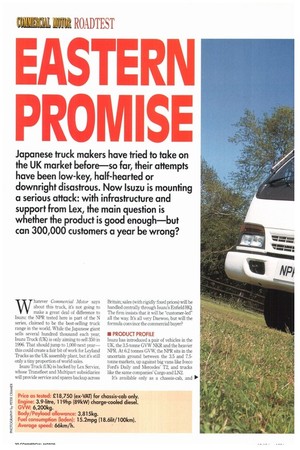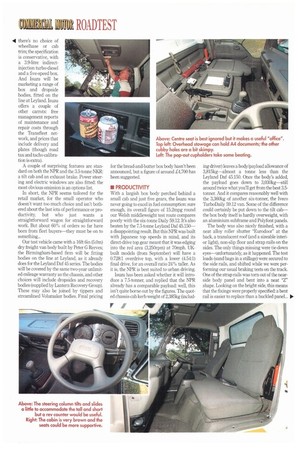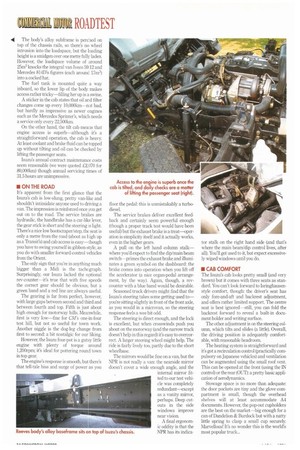EASTERN
Page 34

Page 36

Page 38

Page 39

If you've noticed an error in this article please click here to report it so we can fix it.
PROMISE
Japanese truck makers have tried to take on the UK market before—so far, their attempts have been low-key, half-hearted or downright disastrous. Now Isuzu is mounting a serious attack: with infrastructure and support from Lex, the main question is whether the product is good enough—but can 300,000 customers a year be wrong?
Price as tested: £18,750 (ex-VAT) for chassis-cab only. Engine: 3.9-litre, 119hp (89kW) charge-cooled diesel. GVW: 6,200kg. Body/Payload allowance: 3,815kg. Fuel consumption (laden): 15.2mpg (18.61it/100km). Average speed: 66km/h. Whatever Commercial Motor says about this truck, it's not going to make a great deal of difference to Isuzu: the NPR tested here is part of the N series, claimed to be the best-selling truck range in the world. While the Japanese giant sells several hundred thousand each year, Isuzu Truck (UK) is only aiming to sell 350 in 1996. That should jump to 1,000 next year— this could create a fair bit of work for Leyland Trucks as the UK assembly plant, but it's still only a tiny proportion of world sales.
Isuzu Truck (UK) is backed by Lex Service, whose Transfleet and Multipart subsidiaries will provide service and spares backup across Britain; sales (with rigidly fixed prices) will be handled centrally through Isuzu's Enfield HQ. The firm insists that it will be "customer-led" all the way. It's all very Daewoo, but will the formula convince the commercial buyer?
• PRODUCT PROFILE Isuzu has introduced a pair of vehicles in the UK, the 3.5-tonne GVW NKR and the heavier NPR. At 6.2 tonnes GVW, the NPR sits in the uncertain ground between the 3.5 and 7.5tonne markets, up against big vans like Iveco Ford's Daily and Mercedes' 12, and trucks like the same companies' Cargo and LN2.
It's available only as a chassis-cab, and Po.
there's no choice of wheelbase or cab trim; the specification is conservative, with a 3.9-litre indirectinjection turbo-diesel and a five-speed box. And Isuzu will be marketing a range of box and dropside bodies, fitted on the line at Leyland. Isuzu offers a couple of other carrots: free management reports of maintenance and repair costs through the Transfleet network, and prices that include delivery and plates (though road tax and tacho calibration is extra).
A couple of surprising features are standard on both the NPR and the 3.5-tonne NKR: a tilt cab and an exhaust brake. Power steering and electric windows are also fitted: the most obvious omission is an options list.
In short, the NPR seems tailored for the retail market, for the small operator who doesn't want too much choice and isn't bothered about the last iota of performance or productivity but who just wants a straightforward wagon for straightforward work. But about 60% of orders so far have been from fleet buyers—they must be on to something...
Our test vehicle came with a 16ft Gin (5.0m) dry freight van body built by Peter G Reeves; the Birmingham-based firm will be fitting bodies on the line at Leyland, as it already does for the Leyland Daf 45 series. The bodies will be covered by the same two-year unlimited-mileage warranty as the chassis, and other choices will include dropsides and recovery bodies (supplied by Lantern Recovery Group). These may also be joined by tippers and streamlined Volumaker bodies. Final pricing for the bread-and-butter box body hasn't been announced, but a figure of around £4,700 has been suggested.
• PRODUCTIVITY With a largish box body perched behind a small cab and just five gears, the Isuzu was never going to excel in fuel consumption: sure enough, its overall figure of 15.2mpg round our Welsh middleweight test route compares poorly with the six-tonne Daily 59.12. It's also beaten by the 7.5-tonne Leyland Daf 45.150a disappointing result. But this NPR was built with Japanese top speeds in mind, and its direct-drive top gear meant that it was edging into the red area (3,250rpm) at 70mph. UKbuilt models (from September) will have a 0.728:1 overdrive top, with a lower (4.54:1) final drive, for an overall ratio 24% taller. As it is, the NPR is best suited to urban driving.
Isuzu has been asked whether it will introduce a 7.5-tonner, and replied that the NPR already has a comparable payload: well, this isn't quite borne out by the figures. The quoted chassis-cab kerb weight of 2,385kg (includ
ing driver) leaves a body/payload allowance of 3,815kg—almost a tonne less than the Leyland Daf 45.150. Once the body's added, the payload goes down to 3,030kg—still around twice what you'll get from the best 3.5tonner. And it compares reasonably well with the 3,360kg of another six-tonner, the lveco TurboDaily 59.12 van. Some of the difference could certainly be put down to the tilt cab— the box body itself is hardly overweight, with an aluminium subframe and Polyfont panels.
The body was also nicely finished, with a neat alloy roller shutter "Eurodoor" at the back, a translucent roof (and a sizeable interior light), non-slip floor and strap rails on the sides, The only things missing were tie-down eyes—unfortunately, as it happened. The test loads (sand bags in a stillage) were secured to the side rails, and shifted while we were performing our usual braking tests on the track. One of the strap rails was torn out of the nearside body panel and bent into a neat "Z" shape. Looking on the bright side, this means that the fixings were properly specified: a bent rail is easier to replace than a buckled panel...
411 The body's alloy subframe is percned on top of the chassis rails, so there's no wheel intrusion into the loadspace, but the loading height is a smidgen over one metre fully laden. However, the loadspace volume of around 25m3 knocks the integral van Iveco 59.12 and Mercedes 8141)'s figures (each arounC 17m3) into a cocked hat.
The fuel tank is mounted quite a way inboard, so the lower lip of the body makes access rather tricky—filling her up is a swine.
A sticker in the cab states that oil and filter changes come up every 10,000km—not bad, but hardly as impressive as newer engines such as the Mercedes Sprinter's, which needs a service only every 22,500km.
On the other hand, the tilt cab means that engine access is superb—although it's a straightforward operation, the cab is heavy. At least coolant and brake fluid can be topped up without tilting and oil can be checked by lifting the passenger seats.
Isuzu's annual contract maintenance costs seem reasonable (we were quoted £2,070 for 80,000km) though annual servicing times of 31,5 hours are unimpressive.
• ON THE ROAD
It's apparent from the first glance that the Isuzu's cab is low-slung, pretty van-like and shouldn't intimidate anyone used to driving a van. The impression is reinforced once you get out on to the road. The service brakes are hydraulic, the handbrake has a car-like lever, the gear stick is short and the steering is light. There's a nice low bootscraper/step, the seat is only a metre from the road (about as high up as a Transit's) and cab access is easy—though you have to swing yourself in gibbon-style, as you do with smaller forward-control vehicles from the Orient.
The only sign that you're in anything much bigger than a Midi is the tachograph. Surprisingly, our Isuzu lacked the optional rev-counter it's true that with five speeds the correct gear should be obvious, but a green band and a red line are always useful.
The gearing is far from perfect, however, with large gaps between second and third and between fourth and top. Fifth is just about high enough for motorway hills. Meanwhile, first is very low—fine for CM's one-in-four test hill, but not so useful for town work. Another niggle is the dog-leg change from first to second: a bit nostalgic for our liking.
However, the Isuzu four-pot is a gutsy little engine with plenty of torque around 1,200rpm; it's ideal for pottering round town in top gear.
The engine's response is smooth, but there's that tell-tale hiss and surge of power as you floor the pedal: this is unmistakably a turbodiesel.
The service brakes deliver excellent feedback and certainly seem powerful enough (though a proper track test would have been useful) but the exhaust brake is a treat—operation is simplicity itself and it actually works, even in the higher gears.
A pull on the left hand column stalk— where you'd expect to find the dip/main beam switch—primes the exhaust brake and illuminates a green symbol on the dashboard: the brake comes into operation when you lift off the accelerator (a nice organ-pedal arrangement, by the way). Again, though, a revcounter with a blue band would be desirable.
Seasoned truck drivers might find that the Isuzu's steering takes some getting used to— you're sitting slightly in front of the front axle, as you would in a microvan, so the steering response feels a wee bit odd.
The steering is direct enough, and the lock is excellent, but when crosswinds push you about on the motorway (and the narrow track doesn't help in this regard) it's easy to overcorrect. A larger steering wheel might help. The ride is fairly lively too, partly due to the short wheelbase.
The mirrors would be fine on a van, but the NPR is not really a van: the nearside mirror doesn't cover a wide enough angle, and the internal mirror fitted to our test vehicle was completely redundant—except as a vanity mirror, perhaps. Deep cutouts in the side windows improve near vision.
A final ergonomic oddity is that the NPR has its indica
tor stalk on the right hand side (and that's where the main beam/dip control lives, after all). You'll get used to it, but expect excessively wiped windows until you do.
• CAB COMFORT
The Isuzu's cab looks pretty small (and very brown) but it comes with three seats as standard. You can't look forward to Isringhausenstyle comfort, though: the driver's seat has only fore-and-aft and backrest adjustment, and offers rather limited support. The centre seat is best ignored still, you can fold the backrest forward to reveal a built-in document holder and writing surface.
The other adjustment is on the steering column, which tilts and slides (a little). Overall, the driving position is adequately comfortable, with reasonable headroom.
The heating system is straightforward and it's got a recirculation control (practically compulsory on Japanese vehicles) and ventilation can be augmented using the small roof vent. This can be opened at the front (using the IN control) or the rear (OUT): a pretty basic application of aerodynamics.
Stowage space is no more than adequate: the door pockets are tiny and the glove compartment is small, though the overhead shelves will at least accommodate A4 documents. However, the pop-out cupholders are the best on the market—big enough for a can of Dandelion & Burdock but with a natty little spring to clasp a small cup securely. Marvellous! It's no wonder this is the world's most popular truck... • SUMMARY A best-seller it may be, but the Isuzu NPR goes against the grain for most UK buyers: it offers practically no choice of specification; its performance, payload and fuel economy are nothing special; worst of all, it doesn't even look like a truck.
It excels in no area except initial price, where it undercuts most of the competition by at least .00,000-just don't forget that there's no room for a discount,
But it's exactly what it needs to be as the world's best-selling truck: a perfect piece of compromise. There are enough standard features (such as a tilt cab) to tempt the retail or fleet buyer, but enough economies (such as the basic drivetrain) to keep the price attractively low. And it's completely unintimidatingeasy for the least experienced driver to use, and unlikely to make anybody shout "Juggernaut!" on the High Street.
The NPR is still a work in progress, though: the gearing on our test vehicle needed sorting Out, but we are confident that Isuzu Truck (UK) will get it right before UK production starts in the autumn.
The Isuzu Truck operation is unconventional, so you'd he excused for thinking that the product itself was almost incidental-and for some retail buyers, that will come as a relief. But the UK market is pretty keen on its trucks, and fleet operators will want to be as convinced by the vehicle as they are by the company. Is the NPR good enough to do that? Yes, it's just about good enough.
ID by Toby Clark






























































































































